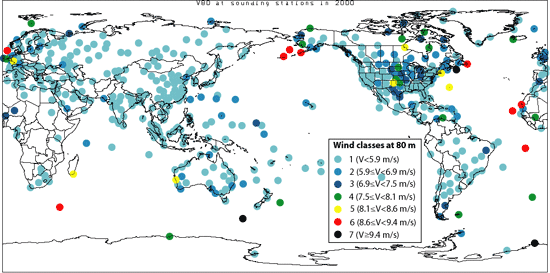Untitled Document
Wind power could generate enough electricity to support the world's energy needs
several times over, according to a new map of global wind speeds that scientists
say is the first of its kind.
The map, compiled by researchers at Stanford University, shows wind speeds
at more than 8,000 sites around the world. The researchers found that at least
13 percent of those sites experience winds fast enough to power a modern wind
turbine. If turbines were set up in all these regions, they would generate 72
terawatts of electricity, according to the researchers.

A new map of global wind speeds shows that wind power has the
potential to produce five times more energy than the world consumes. Photo:
Courtesy of Archer and Jacobson / Journal of Geophysical Research
That's more than five times the world's energy needs, which was roughly 14
terawatts in 2002, according to the U.S. Department of Energy.
The researchers readily admit that existing buildings, land rights and other
obstacles would make it impossible to set up turbines in every single one of
the identified regions. But they point out that even 20 percent of those sites
could satisfy world energy consumption as it stands today.
More importantly, the study shows that wind can be a feasible alternative to
fossil fuels, said study co-author Cristina Archer.
"There is really a lot of wind out there that can be utilized for electricity
generation," said Archer. "The 72-terawatt finding quantifies how
much wind power is available.... It's like when people say how much oil is available
on a global scale. It doesn't mean all of it will be extracted."
If anything, the 72-terawatt figure is likely to be on the low side. Most of
the 8,199 wind-monitoring stations that contributed data to the map are concentrated
in highly developed nations. So the researchers had to make broad and often
conservative estimates for countries in Africa and Asia, and for other regions.
"They are probably significantly underestimating the total potential,"
said Christopher Flavin, CEO of the Worldwatch Institute, an environmental research
firm.
For instance, Flavin pointed to China, which several environmental organizations
have identified as having great potential for wind power. In contrast, the Stanford
map shows only a few locations there having the wind speeds necessary to power
a wind turbine.
Of the regions that are well-marked by the map, North America and parts of
Northern Europe both have a high number of ideal spots for setting up wind turbines.
To date, Northern Europe -- and Denmark in particular -- has made the best use
of that potential. Approximately 20 percent of Denmark's energy consumption
is fulfilled by wind power, according to the Danish Wind Industry Association.
The United States, on the other hand, generates less than 1 percent of its
electricity with wind power.
Archer said it was "ironic and sad" that the United States wasn't
doing more, given the resources available.
"But it's not too late," she said. "We can still do it and I
really hope we do."
The authors' study is scheduled to appear in the Journal of Geophysical Research
-- Atmospheres later this month.

